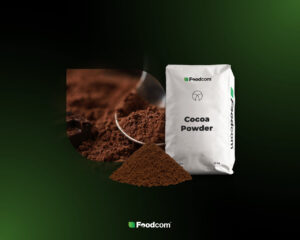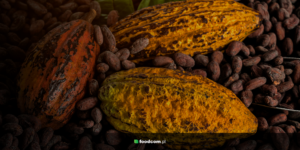- Record prices: Cocoa prices reach historic highs in 2024 due to supply chain disruptions, bad weather and increased demand.
- Production problems in West Africa: Major cocoa-producing regions such as Ghana and Côte d’Ivoire are struggling with low yields due to ageing plantations, disease and logistical challenges.
- Growing demand for premium and organic products: Increased interest in high-quality, organic cocoa products is driving the market, particularly in developing markets.
- Climate and social challenges: Climate change, plant diseases and social issues such as poor working conditions are affecting market stability and production costs.
Cocoa prices have reached record highs in 2024 due to supply chain disruptions, adverse weather, and increased demand. As a key ingredient in confectionery, beverages, and cosmetics, the cocoa market is influenced by several factors, including consumer trends and environmental challenges. The growing popularity of chocolate, particularly in emerging markets, along with rising demand for premium and sustainable products, are key drivers.
However, the sector continues to face hurdles such as price volatility and the impact of climate on production. In major cocoa-producing regions, especially in West Africa, yields are declining due to aging plantations, diseases, and logistical and political challenges. This overview examines how these factors are shaping the market today and their likely implications for the future.
Market Dynamics
The cocoa market in 2024 is characterized by a complex interplay of supply and demand factors, price volatility, and the impact of external forces such as climate change and socio-political conditions in key production regions. Understanding these dynamics is crucial for stakeholders to navigate the market effectively.
Supply and Demand
The global cocoa market remains in a supply deficit in 2024. Major cocoa-producing countries in West Africa (Ivory Coast and Ghana) are reporting lower yields due to aging plantations, diseases, and extreme weather conditions. These countries account for over 70% of the world’s cocoa supply, making any disruption in their production critical to global availability.
Despite production increases in regions like Latin America and Southeast Asia, they have not been able to close the gap caused by West Africa’s challenges. On the demand side, cocoa remains highly sought after. Consumption is increasingly driven by the rise of cocoa powder as an essential ingredient in chocolate and other cocoa-based products in both developed and emerging markets. The shift towards premium and sustainable cocoa is particularly strong in Europe and North America, while emerging markets in Asia and Latin America show growing appetite for chocolate and cocoa products.
Price Volatility
Cocoa prices have surged dramatically, reaching record highs in 2024, with prices exceeding €11,000/MT by year-end. This increase, driven by persistent supply shortages and strong global demand, has significantly impacted the market. Industry responses include shrinkflation (reducing product sizes) and investments in alternative ingredients such as lab-grown cocoa. Despite these high prices, demand has proven resilient, reflecting cocoa’s enduring importance to consumers worldwide.
Environmental and Social Factors
The cocoa industry faces mounting environmental challenges. Climate change continues to intensify issues like plant diseases, including the cocoa swollen shoot virus and black pod disease, which have significantly reduced yields in key producing regions. These environmental pressures are compounded by new EU regulations requiring cocoa to be sustainably sourced, increasing production complexity and costs.
On the social side, the industry grapples with persistent issues like poor working conditions and child labor. Efforts to address these challenges through certification programs, sustainability initiatives, and ethical labor practices have gained momentum but require substantial investment and international collaboration to succeed.
Regional Analysis of the Cocoa Market
West Africa
West Africa, particularly Ivory Coast and Ghana, remains the center of global cocoa production, supplying over 70% of the world’s cocoa. However, in 2024 both regions face significant challenges that continue to impact output and market stability.
Ivory Coast, the largest cocoa producer globally, has struggled with lower yields due to aging trees, diseases such as the cocoa swollen shoot virus, and extreme weather conditions. These challenges have reduced supply, driven up prices, and had significant repercussions for the local economy. Additionally, logistical issues and political instability have further complicated production and export efforts.
Ghana, the second-largest producer, also faces similar difficulties. Plant diseases and climate disruptions have hindered production, despite ongoing efforts to improve farming practices and introduce disease-resistant varieties. In addition, Ghana is a central player in sustainability initiatives, focusing on reducing child labor and promoting better farming methods. These efforts are supported by international organizations and key industry stakeholders, although their full impact remains to be seen.
Latin America
Latin America is solidifying its position as a significant cocoa-producing region, with countries like Brazil, Ecuador, and Peru driving growth through enhanced farming practices and supportive government policies.
Brazil has revitalized its cocoa sector by adopting advanced farming technologies and practices, which have increased yields and improved quality. The country benefits from its diverse climate, which supports cocoa cultivation in multiple regions. However, Brazil continues to face challenges related to deforestation and land-use conflicts, which could impact long-term sustainability.
Ecuador, renowned for its fine-flavor cocoa, remains a key supplier for premium chocolate markets worldwide. Stable production, favorable climate conditions, and government incentives have enhanced its competitive position in the global market. Fine-flavor cocoa remains a vital export for Ecuador, helping the country maintain its reputation as a top producer of high-quality beans.
Peru is another emerging player in the region, focusing on organic and premium cocoa production. Investments in sustainable farming and certification programs have helped the country carve out a niche in global markets.
Southeast Asia
Southeast Asia, including Indonesia, Malaysia, and the Philippines, continues to grow as an alternative source of cocoa production, offering a viable complement to West African supply.
Indonesia, the largest producer in the region, has made strides in improving its cocoa sector through the adoption of disease-resistant varieties and better farming practices. However, aging plantations and challenges with pest management remain key obstacles to sustained growth. Despite this, Indonesia is investing in sustainability and productivity improvements to maintain its role as a major cocoa producer.
Malaysia and the Philippines, while smaller players, are expanding their cocoa sectors. Both countries have launched initiatives to improve yield and quality through government and international support. Malaysia, in particular, is focusing on sustainable farming practices and value-added cocoa products, which enhance its appeal to premium markets. The Philippines is also emphasizing sustainable methods and quality improvements to build its cocoa industry for long-term success.
Europe and North America
Europe is the largest consumer of cocoa products, with countries like Germany, Switzerland, and Belgium leading global chocolate consumption. The region is also home to some of the world’s largest chocolate manufacturers. European consumers are increasingly demanding high-quality, sustainable, and ethically sourced cocoa products, pushing companies to invest heavily in sustainability initiatives and certification programs. These efforts aim to ensure ethical labor practices and environmental responsibility in the supply chain.
North America, led by the United States and Canada, is another significant consumer of cocoa products. In this region, demand is driven by the growing preference for premium, organic, and sustainably sourced chocolate. Major North American companies continue to invest in sustainable sourcing practices, supporting initiatives that aim to improve conditions in cocoa-producing regions. The region is also exploring alternative cocoa production methods, such as lab-grown cocoa, to address supply challenges while meeting consumer expectations for sustainability.
Trends and Forecasts
Cocoa prices are projected to remain high through the end of 2024 and into 2025 due to ongoing supply constraints and strong demand. Supply shortages, driven by climate change, diseases, and socio-political issues, are expected to persist in the short term. While regions like Latin America and Southeast Asia may experience moderate production growth due to improved farming practices, West Africa’s struggles are likely to continue impacting global supply.
Global cocoa consumption is expected to grow, particularly in emerging markets where rising incomes and a growing middle class are driving demand. In established markets, the focus remains on high-quality, premium, and sustainably sourced cocoa products.
The shift towards premium and sustainable cocoa aligns with broader consumer trends emphasizing ethical sourcing and environmental responsibility. Investments in advanced farming techniques, disease-resistant cocoa varieties, and sustainability initiatives will play a crucial role in shaping the industry’s future. As the market evolves, businesses will need to balance innovation and compliance with consumer demands, ensuring resilience and growth in the face of ongoing challenges.
Global Reports from Foodcom S.A.
Curious about what’s next for cocoa? Discover the latest trends and insights that will shape 2025. Visit our blog for regular updates on global reports. Stay informed with Foodcom S.A.
![Cocoa Market Review 2025 [Global Report] Cocoa Market Review 2025 [Global Report]](https://foodcom.pl/wp-content/uploads/2024/08/rynek-kakao-dynamika-rynku-analiza-1520x760.png)







